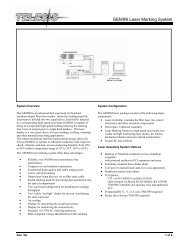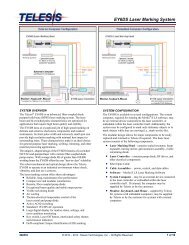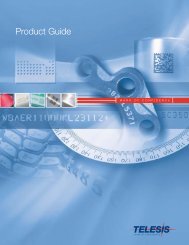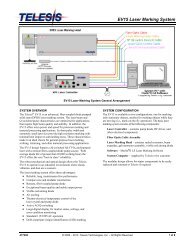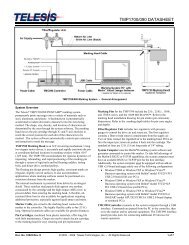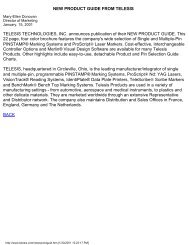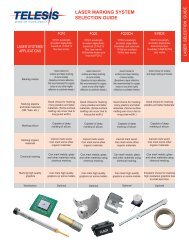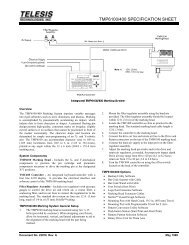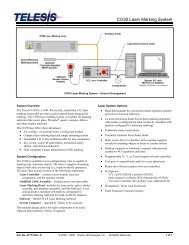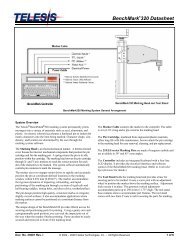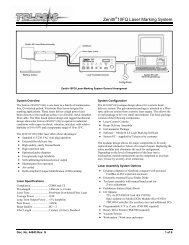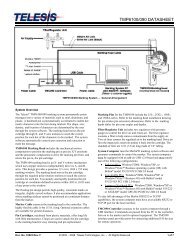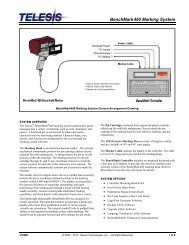Technical Data Sheet - Telesis Technologies, Inc.
Technical Data Sheet - Telesis Technologies, Inc.
Technical Data Sheet - Telesis Technologies, Inc.
Create successful ePaper yourself
Turn your PDF publications into a flip-book with our unique Google optimized e-Paper software.
SYSTEM OVERVIEW<br />
The <strong>Telesis</strong> ® BenchMark ® 200 marking system permanently prints<br />
messages into a variety of materials such as steel, aluminum, and<br />
plastic. An electric solenoid accelerates a hardened pin to indent<br />
dot matrix characters into the item being marked. Character shape,<br />
size, density, and location are determined by the user through the<br />
marking system software.<br />
The BenchMark200 Marking Head is an electromechanical<br />
marker. A thermo-formed cover houses the internal, mechanical<br />
components that position the pin cartridge and fire the marking<br />
pin. A spring returns the pin to its idle position within the<br />
cartridge. The marking head moves the pin cartridge through X-<br />
and Y-axis motions to reach the correct position for each dot of<br />
the characters to be marked. The system software automatically<br />
controls pin extension to mark the message.<br />
The marker uses two stepper-motor drives to rapidly and<br />
accurately position the pin at coordinate-defined locations in the<br />
marking window within 0.032 mm (0.00125 in.). The marker<br />
accommodates the rigorous dynamics of impacting, rebounding,<br />
and rapid positioning of the marking pin through a system of rigid<br />
rails and ball bearing saddles, timing belts, and direct-drive,<br />
toothed pulleys.<br />
The pin design permits high quality, consistent marks on irregular,<br />
slightly curved surfaces. It also accommodates applications where<br />
marking surfaces cannot be positioned at a consistent distance<br />
from the marker.<br />
BenchMark ® 200/BM470 Marking System<br />
BenchMark200/BM470 Marking System – General Arrangement<br />
The Marker Cable connects the marker to the BM470 Controller.<br />
The cable is 4 m (13 ft.) long and is pre-wired to the marking<br />
head.<br />
The Pin Cartridge, machined from engineered plastic materials,<br />
offers long life with little maintenance. Screws attach the pin<br />
cartridge to the marking head for easy removal, cleaning, and pin<br />
replacement.<br />
The 25XLE-series Marking Pins are made of tungsten carbide<br />
and are available in 30° and 45° cone angles.<br />
BM470 Controller contains an integrated keyboard with an LCD<br />
display. It provides a text-only operator interface and allows full<br />
operational control of the marking head. The back panel provides<br />
an electrical interface for connecting optional, remote I/O sources.<br />
Refer to BM470 Controller Specifications for details.<br />
The Tool Stand holds the marking head and provides a base for<br />
securing parts to be marked. It uses a screw jack with an<br />
adjustment wheel to position the marker above the marking<br />
surface. Adjustment locks secure it in place. The generous<br />
vertical adjustment accommodates parts up to 298.4 mm<br />
(11.75 in.) high. The tool stand base contains slots to<br />
accommodate part fixtures. The tool stand comes with two 8mm<br />
T-nuts to aid in securing the parts for marking..<br />
34743A © 2011 –2012 <strong>Telesis</strong> <strong>Technologies</strong>, <strong>Inc</strong>. – All Rights Reserved 1 of 8
BenchMark ® 200/BM470 Marking System<br />
SYSTEM OPTIONS<br />
• Tool Stand Assembly<br />
• Marking Head Extension Cables<br />
• Auxiliary Axis Driver Board Kit<br />
• Motorized Theta-axis with Programmable Rotary Drive Unit<br />
• BM470 Controller Wall-mounting Bracket Kit<br />
• Bar Code Scanner or Bar Code Wand with Cable<br />
• Foot Switch (Start Print) or Pushbutton Station (Start/Abort)<br />
• Backup Utility Software<br />
• Upgrade Utility Software<br />
• Logo/Font Generator Software<br />
• BM470+ Enhanced Communications Software<br />
SYSTEM SETUP<br />
1. Position tool stand assembly in desired location.<br />
2. Mount marking head to the tool stand assembly using four<br />
M8-1.25 socket head cap screws. Screws must extend into<br />
the back plate at least 9mm (0.375 in.) but not more<br />
than 12mm (0.5 in.). Refer to the Benchmark200 Marking<br />
Head Dimensions drawing (above) for details.<br />
CAUTION<br />
The BM470 Controller is not a sealed unit. Protect it from<br />
potentially damaging conditions and contaminants. Do not<br />
block vents in bottom of case. Ensure the marking system<br />
is electrically isolated from any devices that may generate<br />
extreme electromagnetic interference (EMI).<br />
3. Locate controller as close as practical to marking head.<br />
Standard marker cable length is 4 m (13 ft.).<br />
4. Ensure controller power switch (on back panel) is OFF;<br />
connect power cable to controller.<br />
5. Connect marker cable from marking head to controller;<br />
tighten securely.<br />
6. Position controller power switch to ON (on back panel) to<br />
start the marking system software.<br />
7. Adjust pin stroke for proper pin impact depth.<br />
2 of 8 34743A<br />
BENCHMARK200 MARKING HEAD<br />
Specifications<br />
The BenchMark200 marking head specifications are subject to<br />
change without prior notice.<br />
Dimensions ....................... see BenchMark200 Marking Head<br />
Dimensions drawing for details.<br />
Weight .............................. 5.63 Kg (12.375 lb.) marker & cable<br />
5.08 Kg (11.185 lb.) marker only<br />
Noise ................................. 70.9 dB (max); 61.8 dB (LEQ)<br />
See Marking Noise for details<br />
Operating Temperature. ... 0° to 50° C (32° to 122° F),<br />
non-condensing<br />
Marking Area .................... 100 x 100 mm (4.0 x 4.0 in.)<br />
Pin Types .......................... 25XLE-series<br />
Pin Material ....................... Tungsten Carbide<br />
Marking Characteristics<br />
The BenchMark200 can accommodate character sizes from<br />
.762 to 100 mm (.030 to 4.0 in.) in .025 mm (.001 in.) increments.<br />
Characters can be rotated in 1° increments with printing<br />
resolutions from 5 dots/cm (10 dots/in.) to 75 dots/cm<br />
(200 dots/in.) for an engraved look.<br />
Marking Speeds<br />
Generally, the system will mark three characters per second using<br />
5x7 font, 3 mm (.118 in.) high, 2mm (.080 in.) wide characters.<br />
Speeds will vary slightly depending on the selected character size,<br />
style, and dot density. Specific times can be verified by a <strong>Telesis</strong><br />
representative.<br />
Marking Depth<br />
The BenchMark200 can obtain a marking depth of .127 mm<br />
(.005 in.) in mild steel (Rb53) using a 25XLE carbide pin with a<br />
45° cone angle. The depth of mark can be adjusted over a<br />
significant range by changing the impact force (via software<br />
parameter) or by changing the impact distance (pin stroke).<br />
Specific depths can be verified by a <strong>Telesis</strong> representative.<br />
continued...
BENCHMARK200 MARKING HEAD (continued)<br />
Marking Noise<br />
Sound pressure-level tests were conducted on the BenchMark200<br />
Marking System using a Larson-Davis Model 710 sound pressure<br />
meter while dry firing the marker at a 50% duty cycle. The<br />
maximum sound pressure level during the test cycle was measured<br />
at 70.9 dB. The time-weighted average (LEQ) using the 3 db rule<br />
without threshold was 61.8 dB. Typical applications average a<br />
20% to 30% duty cycle where the time-weighted average would<br />
not exceed 70 dB(A).<br />
The sound pressure-level tests were carried out under controlled<br />
conditions, imitating as closely as possible, predicted normal<br />
operation. However, noise level is heavily dependent on the part<br />
being impacted. Conditions such as the material being marked, the<br />
rigidity of the work piece, machine settings, ambient noise, etc.,<br />
may all vary when in operational use. Such variables will alter the<br />
actual noise level.<br />
Despite detailed guidance provided with each machine, variable<br />
operating conditions are beyond the control of <strong>Telesis</strong>. The<br />
responsibility of establishing safe working levels of use remains<br />
with the end user. Accordingly, you should conduct your own<br />
sound pressure-level tests for your application while marking<br />
actual work pieces.<br />
BenchMark ® 200/BM470 Marking System<br />
BenchMark200 Marking Head Dimensions<br />
Pin Life<br />
Pin life depends largely on the type of material being marked, how<br />
hard or abrasive it is, and the required marking depth. On typical<br />
metals with a hardness of Rockwell Rb47, marking at a depth of<br />
.127 mm (.005 in.), carbide pins average approximately 9 million<br />
impressions before needing sharpened.<br />
34743A 3 of 8
BenchMark ® 200/BM470 Marking System<br />
BENCHMARK TOOL STAND<br />
Specifications<br />
The BenchMark Tool Stand specifications are subject to change<br />
without prior notice.<br />
Dimensions (H x W x D) .......... 686.0 x 270.0 x 414.0 mm<br />
(27.0 x 10.63 x 16.29 in.)<br />
Height Adjustment ................... 298.4 mm (11.75 in.)<br />
with standard 25XLE pin/cartridge<br />
Weight ...................................... 13.9 Kg. (30.5 lb.)<br />
Additional Features ............... see BenchMark Tool Stand<br />
Dimensions drawing for details.<br />
BenchMark Tool Stand Dimensions<br />
4 of 8 34743A
BM470 CONTROLLER<br />
Specifications<br />
The BM470 Controller specifications are subject to change<br />
without prior notice.<br />
Compliance ........................... CE, RoHS<br />
Rating ................................... NEMA 1 (I.P. 30)<br />
Mounting Configuration ......... Table-top<br />
Dimensions ............................... see BM470 Controller Dimensions<br />
drawing for details<br />
Weight .................................. 1.68 Kg (3.69 lb.) controller only<br />
Power Requirements ............ 95 to 250 VAC, 2 amps, 50-60 Hz,<br />
single phase<br />
BenchMark ® 200/BM470 Marking System<br />
BM470 Controller Dimensions<br />
Operating Temperature ........ 0° to 50°C (32° to 122° F),<br />
non-condensing<br />
Operating Humidity ............... 10% to 80% non-condensing<br />
Cooling ..................................... Internal, thermostatically-controlled fan<br />
Communications ................... TTL, RS232, and USB *<br />
Input Signals ** ........................ Two available (Start Print, Stop/Abort)<br />
10 VDC (minimum voltage)<br />
30 VDC (maximum voltage)<br />
12 to 24 VDC (nominal voltage)<br />
2.3 mA @ 12VDC; 4.9 mA @<br />
24VDC (nominal current)<br />
** USB for data backup & transfer<br />
** Additional I/O signals available with the optional<br />
BM470+ Enhanced Communications Software<br />
34743A 5 of 8
BenchMark ® 200/BM470 Marking System<br />
BM470 CONTROLLER (continued)<br />
Environmental Considerations<br />
The following environmental considerations must be taken into<br />
account when installing the BM470 controller.<br />
Contaminants. The vented and fan-cooled controller is rated<br />
NEMA 1 (IP30). Accordingly, in environments where solid<br />
and/or liquid contaminants are present, the possibility exists<br />
that these contaminants can be drawn into the controller and<br />
possibly result in failure of a number of electronic components.<br />
For that reason, in these types of environments, the controller<br />
must be located in a sealed industrial enclosure.<br />
EMI Susceptibility. Although the system has been found to be<br />
in compliance with pertinent susceptibility standards, care<br />
should be taken when installing near welders and other extreme<br />
generators of electromagnetic interference (EMI). Particular<br />
care should be taken to ensure welder currents are not injected<br />
through the marking head chassis. The marking head chassis is<br />
connected to the electrical service earth ground through the<br />
marking head cable. The marking head should be electrically<br />
isolated from all surfaces which could become part of a welder<br />
current path.<br />
Interface Panel<br />
The back panel of the controller provides various ports for<br />
connecting the marker and optional accessories. See below.<br />
Marker Port. The Marker port connects the BenchMark200<br />
marking head to the BM470 Controller. It supplies the marking<br />
head with electrical power and provides input/output signals to<br />
and from the controller for marker operation<br />
TTL Port is configured for VDC input only. It allows the system<br />
to connect with a simple contact closure circuit such as a remote<br />
push button station or foot pedal switch. These types of devices<br />
can remotely control Start Print and Stop (Abort) Print operations.<br />
Comm Port allows connection to a remote serial device. The<br />
Comm port may be used to connect an optional, customersupplied<br />
PC to access <strong>Telesis</strong> software utilities. Utility software<br />
may be used to backup patterns stored in the controller, to<br />
download a custom font to the controller, or to download<br />
controller software upgrades. The Comm port also allows you to<br />
connect an optional bar code scanner. The software reads the<br />
scanned input and inserts the data into a variable text field within<br />
the currently loaded pattern.<br />
USB Port allows you to connect a memory stick/flash drive for<br />
pattern storage/retrieval and for software upgrades.<br />
(optional) Auxiliary Axis Port is available only if the controller is<br />
configured with the optional auxiliary-axis circuit card. This<br />
configuration allows connection to a rotational drive unit to make use<br />
of the software’s Theta-axis features.<br />
6 of 8 34743A<br />
System Software<br />
The system software is permanently installed in the controller. It<br />
provides the user interface for the operator to control the marker.<br />
The software also provides a library for storing, loading, and<br />
editing user-defined patterns.<br />
Patterns are files stored in the controller’s memory. Depending on<br />
the size of the pattern files, the controller can store up to 200<br />
patterns. Each pattern contains one or more fields; each field<br />
defines a single object.<br />
Printable objects may be created to define text strings, arc-text<br />
strings, geometric shapes , graphics, and machine-readable data<br />
matrix symbols. Printable text fields may include alphanumeric<br />
characters, symbols, and special message flags. Message flags<br />
automatically insert data into the text string, such as serial<br />
numbers, times, dates and user-defined codes.<br />
Non-printable objects may be defined to specify commands for the<br />
marker to execute (e.g., Go To, Print, Stop).
BM470+ ENHANCED COMMUNICATIONS SOFTWARE<br />
The optional BM470+ Enhanced Communications software allows<br />
you to expand the controller’s communication capability. It makes<br />
full use of the I/O Port available and allows you to configure the<br />
Comm Port communication parameters. See I/O Control Signals and<br />
Host Communications (below) for more information.<br />
I/O Control Signals<br />
Additional input and output signals are available through the I/O<br />
Port only if the system uses the optional BM470+ Enhanced<br />
Communications software. The I/O Port is configured for 12 to 24<br />
VDC I/O only and may be used to connect a PLC or other DC I/O<br />
source. The optically-isolated I/O Port allows you to remotely<br />
select and load patterns, start printing, stop printing, place the<br />
marker online, and monitor the system output signals. Cable<br />
connectors and connector pins are supplied with the controller for<br />
constructing appropriate interface cables.<br />
Input Signals. These input signals provide the following controls:<br />
INPUT COMM ................... For all inputs (+ or – supply)<br />
START PRINT .................. Begins print cycle<br />
STOP ............................... Stops the print cycle<br />
SEL_0 thru _6 * ................. Remotely selects & loads up to<br />
127* pattern files<br />
SPARE_1, 2, 3 .................. Three (3) spares for custom<br />
applications<br />
* System software allows SEL_6 signal to be configured for remotely<br />
selecting patterns or for remotely placing the marker online. If used for<br />
marker online, pattern selection is reduced to 63 patterns (max).<br />
Output Signals. These output signals indicate the following<br />
states:<br />
OUTPUT COMM ............... For all outputs (+ or – supply)<br />
DONE ............................... Print cycle is complete<br />
READY ............................. System ready for message or for start<br />
print command<br />
PAUSED .......................... System paused (waiting timeout or<br />
command)<br />
NO FAULT ....................... System status (normal or fault<br />
detected)<br />
SPARE_1, 2 ...................... Two (2) spares for custom<br />
applications<br />
Host Communications<br />
The BM470+ Enhanced Communications software allows you to<br />
configure the RS-232 parameters for the Comm Port.<br />
The serial interface is most often used to connect a host computer,<br />
a data terminal, or a bar code scanner. The following describes the<br />
serial data character format for all transmissions to and from the<br />
BM470 Controller.<br />
• Asynchronous<br />
• 1200, 2400, 4800, 9600, 19200, 38400, or 115200 Baud<br />
• 1 or 2 Stop Bits<br />
• 7 or 8 <strong>Data</strong> Bits<br />
• None, Even or Odd Parity<br />
BenchMark ® 200/BM470 Marking System<br />
Host Communications (continued)<br />
In addition defining Comm Port communication parameters, you<br />
can select the type of protocol to be used: Extended Protocol or<br />
Programmable Protocol.<br />
Programmable Protocol. Use this protocol where very simple<br />
one-way communications are required (such as with bar code<br />
scanners). Programmable Protocol provides no error checking or<br />
acknowledgment of the transmitted data. Note that XON/XOFF<br />
Protocol applies even when Programmable Protocol is selected.<br />
Starting Character specifies where the software begins to<br />
count character positions. This number must be entered in<br />
decimal format (e.g., “2” for ASCII Start of Text “STX”).<br />
Terminating Character identifies the end of transmitted string<br />
(usually “13” for ASCII carriage return character).<br />
Character Position counted from the starting character<br />
ignoring all characters preceding it.<br />
Character Length accepts variable length messages (if set<br />
to 0) or messages of a pre-specified, fixed number of characters.<br />
Ignore Character identifies the character to ignore when sent<br />
from the host (usually “10” for ASCII line feed character)).<br />
Message Type allows message-type recognition which defines<br />
how the marking system will use data it receives from the host.<br />
1 Message type 1 overwrites the first line of the first text<br />
field with data extracted from the host<br />
P Message type P loads a specific pattern identified by<br />
data extracted from host<br />
Q Message type Q updates the text in the first query<br />
buffer with data extracted from the host<br />
V Message type V updates the first variable text flag<br />
found in the pattern with data extracted from the host<br />
0 Message type 0 (zero) indicates that host will provide<br />
message type, field number (if applicable), line number<br />
(if applicable), and data; delegates message type<br />
selection to the host on message-by-message basis.<br />
The host message must use the format:<br />
Tnn<br />
where:<br />
T = 1, P, Q, or V to indicate message type<br />
nn = two-digit field number or query text buffer<br />
where data will be placed.<br />
Note: Not used with Message Type P.<br />
= For Message Type P, indicates the pattern<br />
name to be loaded.<br />
For Message Types 1, Q, or V, indicates<br />
the data to be inserted into the field or the<br />
query text buffer, as applicable.<br />
34743A 7 of 8
BenchMark ® 200/BM470 Marking System<br />
BM470+ ENHANCED COMMUNICATIONS (continued)<br />
Host Communications (continued)<br />
Extended Protocol. This protocol selection includes error checking and transmission acknowledgment. It should be used in applications<br />
where serial communication is a vital part of the marking operation. All communications are carried out in a parent/child relationship with the<br />
host being the parent. Only the host has the ability to initiate communications. If the host does not receive a response within three seconds, it<br />
should re-transmit its original message. If no response is received after three tries, it should declare the link to be down.<br />
The following describes the Extended Protocol message format as<br />
sent from the host to the BM470 controller.<br />
SOH TYPE [##] STX [DATA] ETX BCC CR<br />
where:<br />
SOH ASCII Start of Header character (001H). The controller<br />
ignores all characters received prior to the SOH.<br />
TYPE A single, printable ASCII character that defines the<br />
meaning (type) and content of the message downloaded<br />
from the host, where:<br />
1 Message Type 1 overwrites a specific field in<br />
currently loaded pattern with data supplied in the<br />
host message. See [DATA] for details.<br />
P Message Type P specifies the pattern name to be<br />
loaded for printing. See [DATA] for details.<br />
Q Message Type Q updates a specific query buffer<br />
with data supplied in the host message.<br />
See [DATA] for details.<br />
V Message Type V updates the variable text in a<br />
specific text field of the currently loaded pattern with<br />
data supplied in the host message.<br />
See [DATA] for details.<br />
O Message Type O resets marker and places it online<br />
G Message Type G initiates a print cycle to mark the<br />
currently loaded pattern<br />
I Message Type I requests the marker return the<br />
status of standard output and input signals. The<br />
system will return a hexadecimal code for the 6<br />
output signals and 12 input signals in the following<br />
format:<br />
OO;III<br />
where:<br />
bit 1 READY 0x01<br />
bit 2 DONE 0x02<br />
bit 3 PAUSED 0x04<br />
bit 4 NO_FAULT 0x08<br />
bit 5 SPARE_1 0x10<br />
bit 6 SPARE_2 0x20<br />
bit 1 START 0x001<br />
bit 2 STOP 0x002<br />
bit 3 SEL_0 0x004<br />
bit 4 SEL_1 0x008<br />
bit 5 SEL_2 0x010<br />
bit 6 SEL_3 0x020<br />
bit 7 SEL_6 * 0x040<br />
bit 8 SEL_4 0x080<br />
bit 9 SEL_5 0x100<br />
bit 10 SPARE_1 0x200<br />
bit 11 SPARE_2 0x400<br />
bit 12 SPARE_3 0x800<br />
Note: Input SEL_6 may be configured<br />
to place machine online (default)<br />
or for Remote Pattern Selection.<br />
8 of 8 34743A<br />
[##] Optional two-digit ASCII number that specifies the Station<br />
ID of the controller when used in multi-drop network<br />
applications. The Station ID may range from 00-31. Note<br />
that “00” is reserved for applications where only one<br />
controller is used. In such applications, this field may be<br />
eliminated and “00” will be assumed.<br />
STX ASCII Start of Text Character (002H).<br />
[DATA] Optional character string that may be required for certain<br />
message types (e.g., Type 1, P, Q, and V).<br />
Typically, data is sent in the format:<br />
nn.<br />
where:<br />
nn = two-digit field number or query text buffer<br />
where data will be placed.<br />
Note: Not used with Message Type P.<br />
= For Message Type P, indicates the pattern<br />
name to be loaded.<br />
For Message Types 1, Q, or V, indicates<br />
the data to be inserted into the field or the<br />
query text buffer, as applicable.<br />
ETX ASCII end of text character (003H).<br />
BCC Optional Block Check Code that is generated and sent to<br />
improve link reliability by providing fault detection. The<br />
BCC is calculated by taking an eight bit addition of the<br />
TYPE and DATA TEXT characters and transmitting them<br />
as a three digit ASCII decimal number in the range from<br />
000 to 255. If the sum is greater than 255, the most<br />
significant bit overflows and is discarded.<br />
CR ASCII Carriage Return Character (00DH).<br />
TRADEMARKS<br />
<strong>Telesis</strong> and BenchMark are registered trademarks of<br />
<strong>Telesis</strong> <strong>Technologies</strong>, <strong>Inc</strong>. in the United States.



